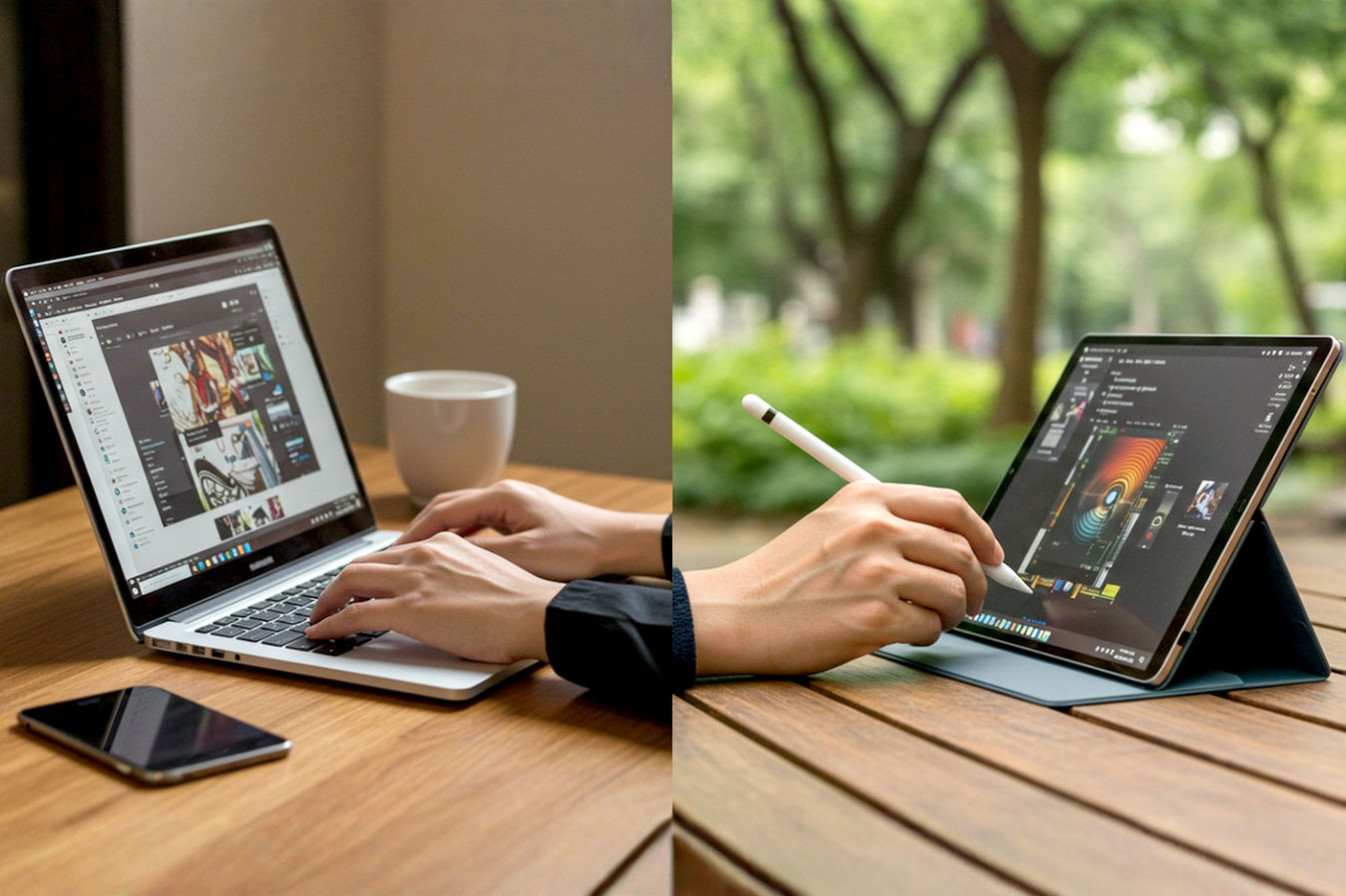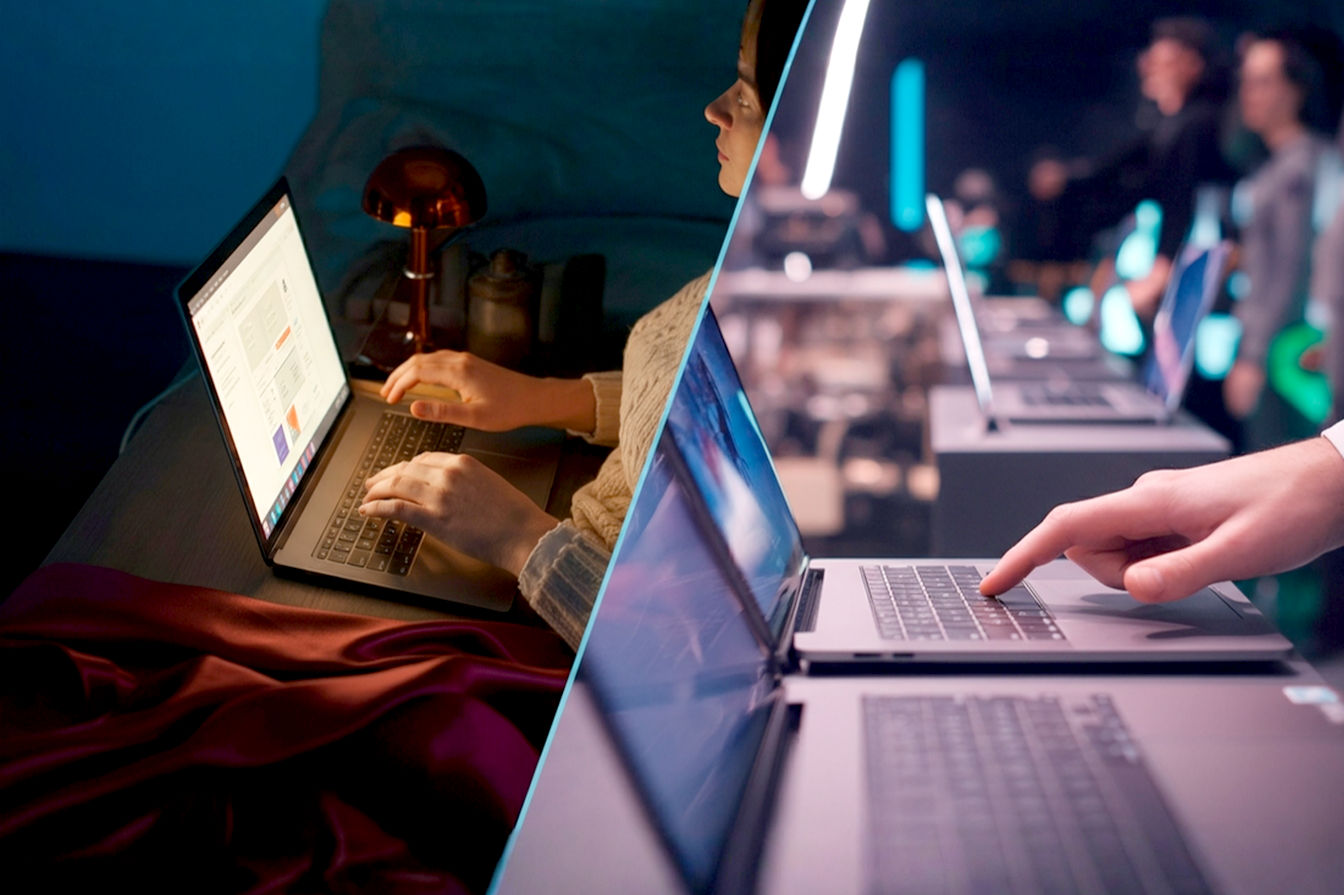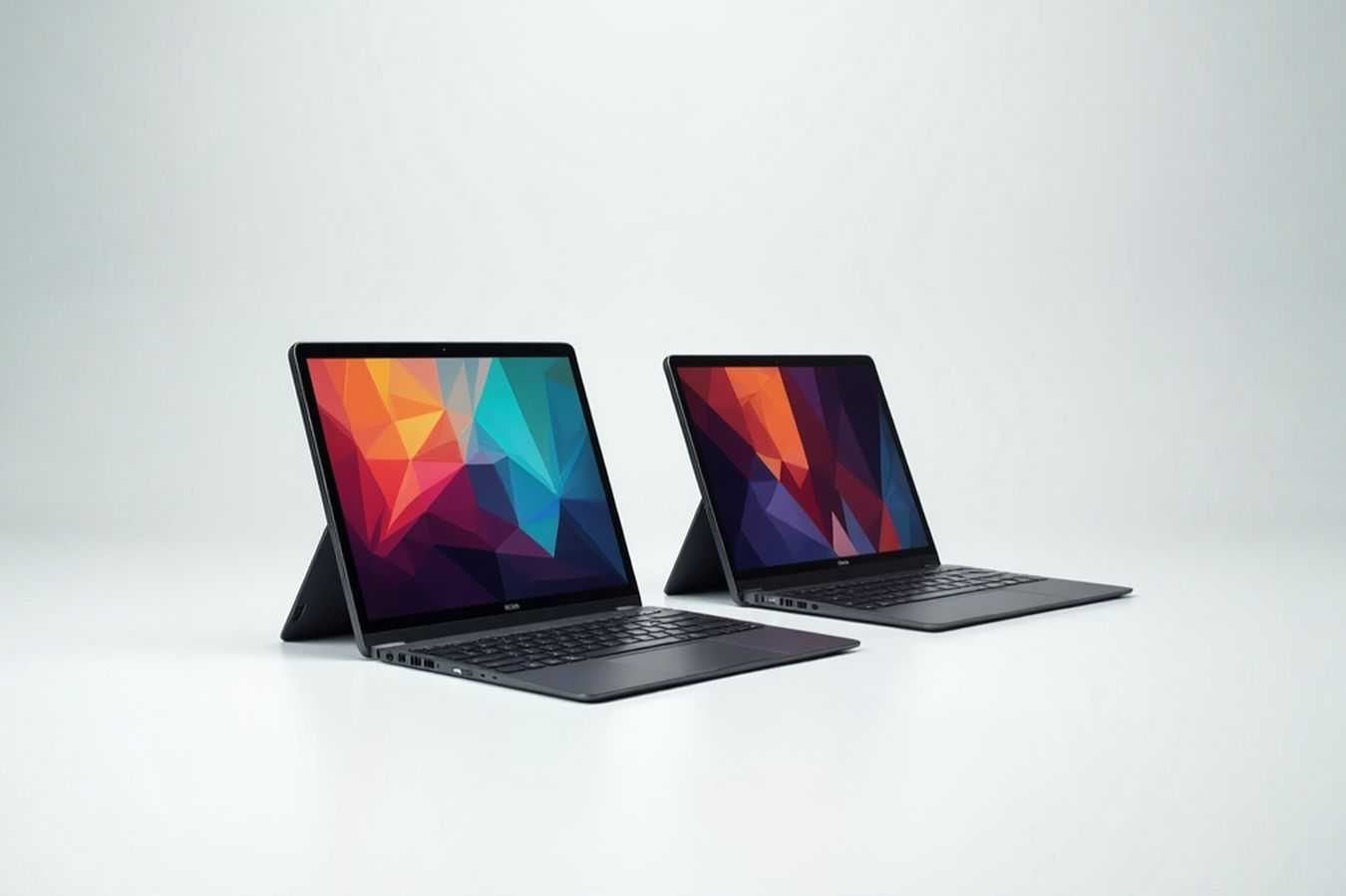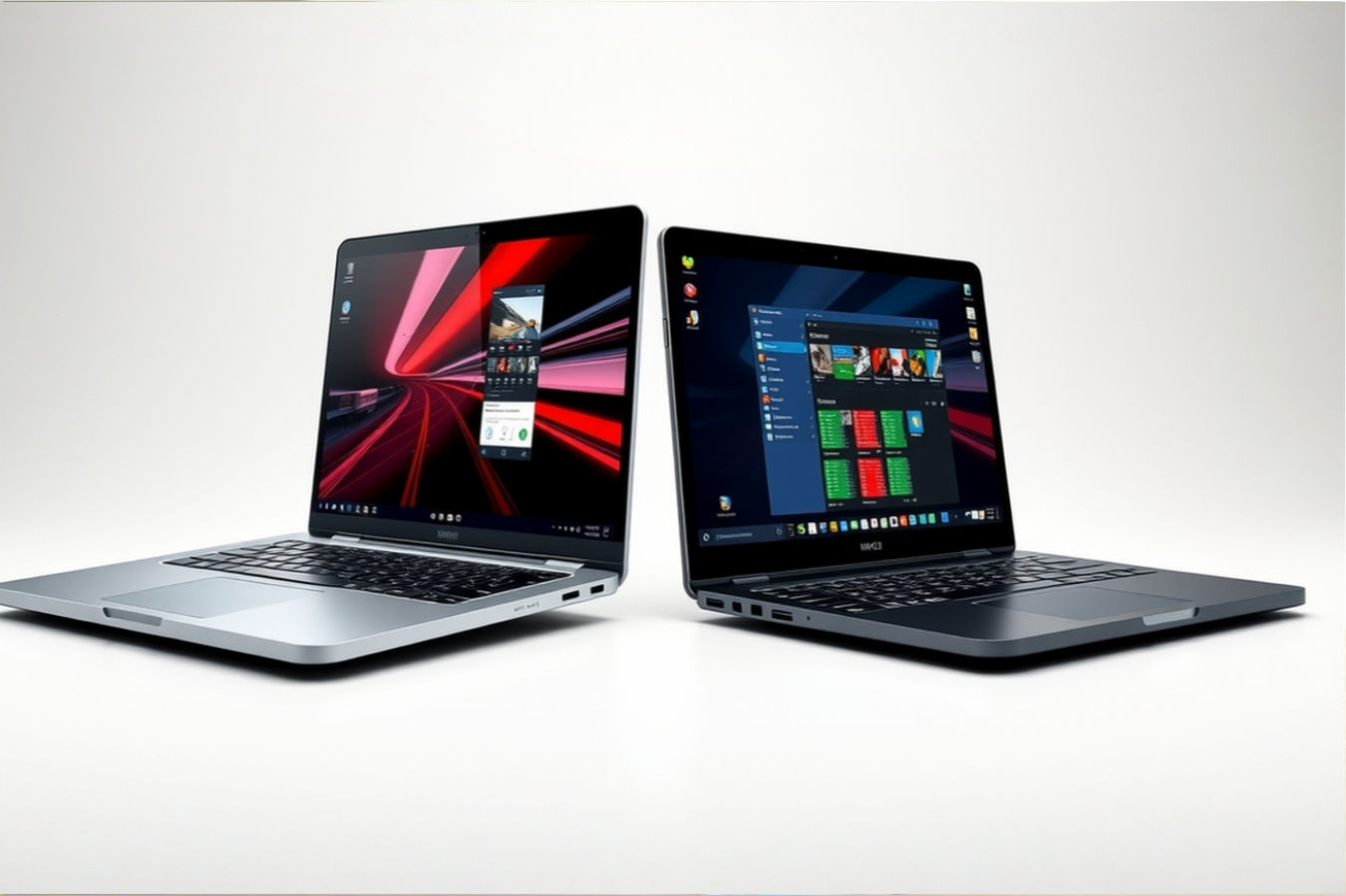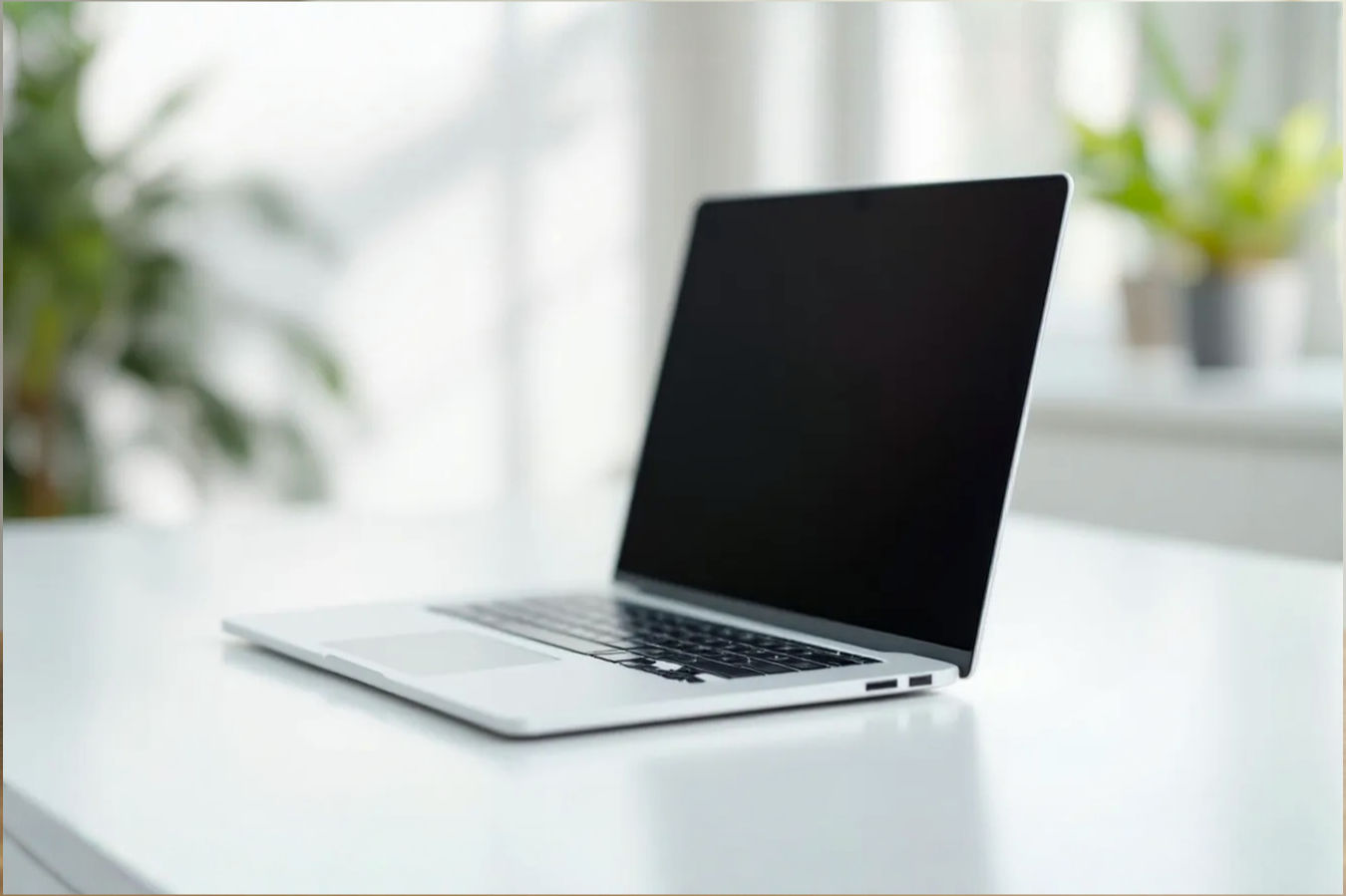This post may contain affiliate links. If you make a purchase through these links, we may earn a commission at no additional cost to you.
The world of personal computing has changed a lot. Gone are the days when your only real choice was a standard laptop or a desktop computer. Today, we have a fantastic range of devices designed to fit different needs and lifestyles. Among the most popular are hybrid devices that try to give you the best of both worlds: the power of a laptop and the flexibility of a tablet. Two main types stand out in this category: detachable laptops and 2-in-1 convertible laptops.
Both types offer versatility, letting you switch between modes depending on what you’re doing. But they achieve this versatility in different ways, and those differences can significantly impact how you work, create, and play. Choosing the right one isn’t just about picking a cool gadget; it’s about finding the tool that genuinely enhances your daily workflow. This guide will break down exactly what makes each type unique, compare their strengths and weaknesses, and help you figure out which device is the perfect match for you.
Understanding Detachable Laptops
Let’s start by looking closely at detachable laptops. These devices are essentially tablets first, designed with the primary intention of being used as a touchscreen slate. They come with a keyboard accessory that can be completely removed, or “detached,” from the screen portion.
What is a Detachable Laptop?
At its core, a detachable laptop is a tablet that pairs with a keyboard. The screen houses most, if not all, of the crucial components like the processor, memory, storage, and battery. The keyboard is often a thin, lightweight accessory that connects via a physical connector, often magnetic. When the keyboard is attached, the device functions much like a traditional laptop. When removed, you have a standalone tablet.
Think of devices like the Microsoft Surface Pro or the HP Spectre Folio. These are prime examples where the tablet part is the main unit, and the keyboard is an add-on, sometimes even sold separately. This design prioritizes the tablet experience, making the screen unit comfortable and capable for touch-based tasks, reading, or media consumption without the bulk of a keyboard attached.
The Design and Mechanics
The defining feature of a detachable laptop is how the keyboard connects and disconnects. This usually happens through a magnetic connector or sometimes a physical latching mechanism. Magnetic connections are common because they are simple and quick. You just snap the keyboard into place, and it connects instantly, often providing both power and data transfer.
The keyboard base itself can vary. Some are very thin and flexible, offering basic typing and protection for the screen. Others are more robust, providing a more traditional typing feel and sometimes housing extra ports or even a secondary battery, though this is less common in modern designs. The main power source and the central processing unit (CPU) are almost always located in the screen portion to allow it to function independently as a tablet. This design choice impacts everything from performance potential to battery distribution.
Typical Use Cases for Detachables
Detachable laptops really shine in scenarios where you frequently switch between needing a keyboard for typing and wanting a pure tablet experience.
Here are some common ways people use them:
- Prioritizing Tablet Use: If you spend a lot of time reading e-books, browsing the web on the couch, sketching with a stylus, or watching movies and shows, the detachable form factor is excellent. You can easily ditch the keyboard and use the lightweight tablet.
- Light Productivity on the Go: For answering emails, writing short documents, or managing tasks while standing or in tight spaces (like on a train), the tablet with a digital pen or the attached keyboard provides enough functionality.
- Situations Where a Full Laptop Isn’t Needed: In meetings where you’re primarily taking notes with a stylus, or during presentations where you just need the screen, detaching the keyboard makes the device less intrusive and easier to handle.
Because the main components are in the screen, detachable tablets can sometimes feel a bit top-heavy when the keyboard is attached, especially on your lap. They often work best on a stable surface like a desk or table when used in laptop mode.
Understanding 2-in-1 Convertible Laptops
Now, let’s look at the other side: 2-in-1 convertible laptops. Unlike detachables, these devices keep the keyboard permanently attached to the screen. Their versatility comes from a special hinge that allows the screen to rotate or fold back a full 360 degrees.
What is a 2-in-1 Convertible Laptop?
A 2-in-1 convertible laptop starts life as a traditional laptop. It has a keyboard base and a screen connected by a hinge. The magic happens with this hinge, which lets you flip the screen all the way around until it rests against the back of the keyboard base. This transforms the device into a tablet-like form factor, though the keyboard is still physically attached, just hidden underneath.
Popular examples include the Lenovo Yoga series, HP Spectre x360, and Dell Inspiron 2-in-1 models. These devices are typically designed with a strong emphasis on the laptop experience first, offering more robust keyboards and often more powerful internal components than many detachables.
The Hinge Mechanism
The 360-degree hinge is the defining characteristic of a convertible laptop. This hinge is engineered to be durable enough to withstand repeated opening and closing, as well as rotating the screen completely. When you fold the screen back past about 180 degrees, the keyboard and touchpad usually automatically disable to prevent accidental input.
This hinge allows for multiple ways to use the device, often referred to as “modes”:
- Laptop Mode: The standard configuration, just like any laptop.
- Tablet Mode: The screen is folded all the way back, turning the device into a thicker tablet.
- Tent Mode: The device is propped up like a tent, useful for touch interaction or watching media in tight spaces.
- Stand (or Display) Mode: The keyboard base is folded back to act as a stand, with the screen facing forward. This is great for presentations or watching videos when you don’t need the keyboard.
The hinge adds complexity and can potentially be a point of failure over time, although modern hinges are built to be quite robust. The weight of the keyboard base also provides stability when using the device in traditional laptop mode, especially on your lap.
Typical Use Cases for Convertibles
2-in-1 convertibles are ideal for users who primarily need a laptop but want the flexibility to occasionally use the device in other orientations for specific tasks.
Here’s where convertibles shine:
- Prioritizing Laptop Use with Occasional Touch/Tablet Interaction: If your main work involves typing, spreadsheets, or coding, but you sometimes need to use a touchscreen for quick navigation, drawing, or signing documents, a convertible is a natural fit.
- Presentations and Collaboration: Tent or stand mode is excellent for showing content to a small group without needing an external stand. You can easily share your screen and interact via touch.
- Note-Taking or Sketching While Keeping the Keyboard Handy: Unlike a detachable where the keyboard is completely separate, a convertible lets you fold the screen back for note-taking with a stylus, then quickly flip it back to laptop mode to type up your notes.
Because the keyboard is always attached, convertibles are generally thicker and heavier in tablet mode compared to detachables. However, this attached base provides excellent stability when used as a laptop on uneven surfaces like your lap.
Key Differences: Detachable vs. Convertible
While both device types offer a blend of laptop and tablet functionality, their fundamental designs lead to significant differences in how they feel and perform in various situations. Understanding these distinctions is crucial for making the right choice.
Form Factor and Versatility
The most obvious difference lies in their physical design and the degree of versatility they offer.
- Detachable: These devices offer the truest tablet experience when the keyboard is removed. The screen unit is designed to be a comfortable, portable tablet on its own. However, the keyboard base is often less rigid than a traditional laptop base, and the connection point can sometimes feel less stable, particularly when using the device on your lap. When the keyboard is attached, the device can sometimes feel top-heavy because all the main components are in the screen.
- Convertible: Convertibles maintain a traditional laptop form factor with a permanently attached keyboard. This provides a very stable and familiar laptop experience. The versatility comes from the ability to fold the screen back. While they can be used in a tablet-like mode, they are generally thicker and heavier than a standalone detachable tablet because the keyboard is still part of the device, just folded away. The weight distribution is more balanced, making them feel more stable on your lap in laptop mode.
The core distinction is whether you want a tablet that can become a laptop (detachable) or a laptop that can become a tablet (convertible).
Keyboard and Typing Experience
The keyboard is a critical part of any productivity device, and there are notable differences here.
- Detachable: Keyboards for detachable laptops are often designed to be thin and light to complement the tablet’s portability. This can sometimes mean shallower key travel (the distance a key moves when pressed) and a less satisfying typing feel compared to a standard laptop keyboard. The connection to the tablet can also sometimes make the keyboard feel less stable or prone to flexing, especially if it’s a thin cover-style keyboard. Some premium detachables offer better keyboard experiences, but it’s a common trade-off for the thin design.
- Convertible: Since convertibles start as laptops, their keyboards generally offer a more traditional typing experience. They are usually built into a solid base, providing better key travel, spacing, and overall stability. This makes them more comfortable for long typing sessions. The touchpad is also typically larger and more robust on a convertible compared to the often smaller touchpads found on detachable keyboards.
If typing comfort and speed are high priorities for you, a convertible is often the better choice.
Performance and Components
The internal components and how they are cooled can differ significantly between the two types, impacting performance.
- Detachable: Because the screen unit needs to be thin and cool enough to hold comfortably as a tablet, detachable laptops often use processors designed for lower power consumption and thermal output. These might be Intel Core i3/i5/i7 U-series processors or ARM-based chips like the Qualcomm Snapdragon series. While capable for everyday tasks, they might not offer the same raw power as chips found in larger laptops. The limited space also means dedicated graphics cards are rare; they almost exclusively rely on integrated graphics.
- Convertible: Convertibles, with their thicker bases, generally have more room for cooling systems and can accommodate more powerful processors, including Intel Core i5/i7/i9 H-series or AMD Ryzen 7/9 processors, which offer higher performance. While many convertibles also use integrated graphics, some larger or higher-end models can include dedicated graphics cards from NVIDIA (like GeForce RTX) or AMD (Radeon), making them suitable for more demanding tasks like video editing, 3D modeling, or gaming.
For workflows requiring significant processing power or graphical capability, a convertible typically offers more options.
Portability and Weight
While both are designed to be portable, the nature of their design affects how that portability feels.
- Detachable: The tablet portion of a detachable laptop is usually very light and thin, making it extremely portable when separated from the keyboard. This is great for carrying around like a notepad or using on an airplane tray table without the keyboard. However, when the keyboard is attached, the total weight can be comparable to, or sometimes even more than, a similarly sized convertible, and the combined unit can feel a bit awkward or top-heavy.
- Convertible: The weight of a convertible laptop is constant, as the keyboard is always attached. They are generally heavier than a detachable tablet alone but often similar in total weight to a detachable with its keyboard attached. The weight is distributed more evenly across the base, which contributes to better stability on your lap. Their thickness in tablet mode can also make them feel less portable as a pure tablet compared to a detachable.
If maximum lightness and thinness in tablet mode are your priority, a detachable wins. If consistent, balanced weight and stability in laptop mode are more important, a convertible might be better.
Battery Life Distribution
The location of the battery can affect how long each part of the device lasts.
- Detachable: The primary battery is almost always located in the tablet section. This ensures the tablet can function independently. Some older or larger detachable keyboards might have a secondary battery, but this is less common now. This means that while the tablet alone has battery life, using it with the keyboard attached draws power primarily from the tablet’s battery.
- Convertible: The battery in a convertible is housed in the main base, similar to a traditional laptop. This provides a stable power source for all components, regardless of the screen’s orientation.
While overall battery life can vary greatly depending on components and usage, the distribution means a detachable tablet will have a certain battery life on its own, while a convertible’s battery life is tied to the entire unit. High-performance components often found in convertibles can also lead to shorter battery life under heavy load compared to the more power-efficient chips often used in detachables.
Comparing Workflows: Which Device Fits You?
The best way to choose between a detachable and a 2-in-1 convertible is to think deeply about your daily tasks and how you prefer to work. Which device aligns better with your most frequent activities?
For the Mobile Professional
If your job involves a lot of travel, moving between meetings, giving presentations, and needing to quickly jot down notes or access information, both types offer advantages, but one might suit you better.
- Convertible Advantages: A convertible’s ability to quickly switch between laptop, tent, and stand modes without detaching anything is a major plus. You can be typing an email, then instantly flip it into stand mode to show a colleague something on screen, or into tent mode for a quick touch interaction during a presentation. The stable base makes it easier to use on a train or plane tray table.
- Detachable Considerations: A detachable is great for carrying just the tablet to a meeting for note-taking or using it as a lightweight reader during a commute. However, if you need to frequently switch to typing or use it on an unstable surface, attaching and using the keyboard might be less convenient or stable than a convertible.
For the professional who needs a reliable laptop first but benefits from flexible modes for collaboration and presentations, a convertible often provides a smoother, more stable experience.
For the Creative or Student
Students and creative professionals often have workflows that blend typing, research, note-taking, sketching, and media consumption.
- Tablet Mode Importance: Both groups often benefit greatly from using a stylus for handwritten notes, annotating PDFs, or creating digital art. This makes the quality of the tablet experience and stylus support critical. A detachable, being lighter and thinner as a tablet, often feels more like a natural notepad or sketchpad.
- Integrated Keyboard Need: However, students also need to write essays and do research, and creatives might need to run demanding design software. A convertible provides a more robust typing experience for long writing sessions and often has access to more powerful components needed for creative applications.
If your creative or academic work heavily involves extensive handwriting, sketching, or using the device primarily as a digital notebook, a detachable might be preferable due to its superior tablet form factor. If your workflow is a more even split between typing/heavy computing and occasional note-taking/sketching, or if you need more power, a convertible is likely a better fit.
For Light Computing & Media Consumption
If your primary use is browsing the web, checking social media, streaming videos, reading, and light office tasks, both can handle these, but the user experience differs.
- Detachable Shines: For pure media consumption and casual browsing, a detachable tablet without the keyboard is incredibly convenient. It’s lightweight, easy to hold, and feels just like a regular tablet.
- Convertible Flexibility: A convertible in stand or tent mode is also excellent for watching movies or using touch-based apps, but the attached keyboard adds weight and bulk, making it less ideal for holding for extended periods like a book or magazine.
For users whose primary need is a versatile device for casual use and media consumption, the pure tablet experience offered by a detachable often makes it the more enjoyable choice.
For Power Users & Demanding Tasks
Users who need to run demanding software like video editors, CAD programs, development environments, or perform complex data analysis require significant processing power, ample RAM, and sometimes dedicated graphics.
- Convertible Performance Edge: As discussed earlier, convertibles generally offer configurations with more powerful processors and sometimes dedicated graphics cards. Their larger size allows for better cooling systems, which means these components can run at higher performance levels for longer periods without overheating.
- Detachable Limitations: While there are some high-performance detachables (like certain configurations of the Surface Pro), they are less common and often more expensive. The thermal limitations of a thin tablet form factor mean that even with powerful chips, sustained heavy workloads might lead to performance throttling (the device slowing itself down to manage heat).
For workflows that consistently require high performance and the ability to run demanding applications, a convertible is almost always the better and more reliable option.
Performance, Specs, and Price
Beyond the form factor, the technical specifications and cost are major factors in deciding between a detachable and a 2-in-1 convertible.
Processor and Graphics
The engine of any computer is its processor (CPU), and the graphics processing unit (GPU) handles visuals.
- Typical Processors: Most detachables and convertibles use processors from Intel (like Core i3, i5, i7, or the newer Core Ultra series) or AMD (Ryzen 3, 5, 7, 9). Detachables often favor Intel’s lower-power U-series or ARM-based chips like Qualcomm Snapdragon, optimized for battery life and thermal efficiency in a thin chassis. Convertibles frequently use more powerful Intel P-series or H-series, or AMD HS-series processors, designed for higher performance in more traditional laptop form factors.
- Graphics: Integrated graphics, where the GPU is part of the CPU chip, are standard in most of these devices. Examples include Intel Iris Xe or AMD Radeon Graphics. These are fine for everyday tasks, streaming, and light photo editing. Dedicated graphics cards (like NVIDIA GeForce RTX or AMD Radeon RX), which have their own memory and processing power, are rare in detachables but available in some higher-end convertibles, significantly boosting performance for gaming, video editing, and 3D work.
If your work involves tasks that are heavily reliant on the CPU or require significant graphical processing, pay close attention to the specific processor model and whether the device includes dedicated graphics. A more powerful chip will have a higher Thermal Design Power (TDP), meaning it generates more heat and requires a more robust cooling system, which is easier to implement in the thicker base of a convertible.
RAM and Storage
Memory (RAM) affects how many programs you can run smoothly at once, and storage (SSD) determines how much data you can keep on your device and how quickly it accesses files.
- RAM: Most detachables and convertibles come with 8GB or 16GB of RAM. For basic tasks like web browsing and office applications, 8GB is usually sufficient. For multitasking with many applications open, running virtual machines, or working with large files (like in photo or video editing), 16GB or even 32GB is highly recommended. Most of these devices have RAM soldered directly to the motherboard, meaning you can’t upgrade it later, so choose wisely upfront.
- Storage: Solid State Drives (SSDs) are standard now, offering much faster performance than older Hard Disk Drives (HDDs). Storage capacities range from 128GB up to 1TB or more. For most users, 256GB or 512GB is a good starting point. Like RAM, storage is often soldered or uses a specific form factor (like M.2) that might be difficult or impossible for the user to upgrade, depending on the model.
Consider your current and future needs for multitasking and file storage when looking at RAM and SSD options.
Display Quality and Stylus Support
The screen is your primary interface, especially in tablet modes.
- Display Quality: Look for resolution (Full HD 1920×1080 is standard, higher resolutions like 2K or 4K offer sharper images), color accuracy (important for creative work), and brightness (measured in nits, higher is better for outdoor use). OLED panels offer vibrant colors and true blacks, but can be more expensive.
- Touch and Pen Support: Both detachables and convertibles feature touchscreens. The quality of the touch response varies. Stylus support is a major feature for many users. Look for devices that support active pens, which offer pressure sensitivity (for drawing and variable line thickness) and sometimes tilt support. Passive styluses are just pointers and don’t offer these advanced features. Some devices include the pen, while others sell it separately. The technology behind the pen (like Microsoft Pen Protocol – MPP, or Wacom AES) affects compatibility and performance.
If note-taking, drawing, or annotating documents is a key part of your workflow, prioritize a device with excellent touchscreen responsiveness and robust active pen support.
Connectivity and Ports
How you connect external devices, monitors, and networks is important.
- Port Variety: Traditional laptops offer a wide range of ports (USB-A, USB-C, HDMI, Ethernet, SD card readers). Detachable laptops, especially thinner ones, often have fewer ports, sometimes only one or two USB-C ports. Convertibles generally offer a better selection of ports due to their thicker chassis.
- USB-C and Thunderbolt: USB-C is becoming standard, offering power delivery, data transfer, and video output over a single cable. Thunderbolt (often found on higher-end Intel-based machines) is a faster version of USB-C, allowing for connections to high-speed storage, multiple 4K monitors, and external graphics enclosures (eGPUs) with a single cable.
- Dongles and Docks: If a device lacks the ports you need, you’ll have to rely on dongles or docking stations, which add cost and complexity.
Consider what peripherals you use regularly (external monitors, hard drives, mice, keyboards, projectors) and ensure the device has the necessary ports or that you factor in the cost and inconvenience of adapters.
Battery Life Expectations
Battery life is crucial for portability, but advertised numbers don’t always reflect real-world usage.
- Usage Impact: Battery life is heavily dependent on what you’re doing. Demanding tasks like running complex software, gaming, or streaming high-resolution video drain the battery much faster than web browsing or typing. Screen brightness is also a major factor.
- Typical Ranges: Generally, you can expect anywhere from 6 to 12+ hours of battery life on a single charge, depending on the device, its components, and your usage. Devices with power-efficient processors (like ARM or Intel U-series) tend to last longer, while those with high-performance chips and dedicated graphics will have shorter battery life under load.
- Detachable vs. Convertible: While generalizations are tricky, detachables with power-efficient chips can offer excellent battery life, especially when used as a tablet. Convertibles with more powerful components might have shorter battery life during intensive tasks but can still last a full workday with lighter use.
Always look at independent reviews for real-world battery life tests, as manufacturers’ claims are often based on very light usage scenarios.
Price Range and Value
The cost of these versatile devices varies widely.
- General Tiers: Both detachables and convertibles are available across budget, mid-range, and premium price points. Budget models might start from a few hundred dollars, while high-end configurations can exceed $2000 or $3000.
- Detachable Pricing: Budget detachables (like some Chromebooks or entry-level Windows tablets) can be quite affordable, but often have lower performance and screen quality. Premium detachables, like the Surface Pro line, are priced similarly to premium laptops, especially when you include the cost of the keyboard and stylus (which are sometimes optional extras).
- Convertible Pricing: Convertibles tend to have a wider range of configurations, from budget models with basic specs to high-performance workstations with dedicated graphics. Their pricing often aligns closely with traditional laptops of similar specifications, with a premium added for the 2-in-1 functionality.
When comparing prices, make sure you’re comparing devices with similar specifications. Also, factor in the cost of essential accessories like the keyboard (if not included with a detachable) and a stylus if you plan to use one. Sometimes, a slightly more expensive device upfront might offer significantly better performance or features that save you money on accessories or improve productivity in the long run, representing better overall value.
Pros and Cons Summary
To quickly recap the strengths and weaknesses of each type, here’s a summary:
Detachable Laptop Pros
- Excellent Tablet Experience: When the keyboard is removed, it feels and functions like a lightweight, comfortable tablet.
- Lighter as a Tablet: Significantly lighter than a convertible when used in tablet mode alone.
- Can Be More Portable Without the Keyboard: Ideal for carrying just the screen for reading, sketching, or quick tasks.
Detachable Laptop Cons
- Keyboard Often Less Robust: Keyboards can be thin, flexible, and offer a less satisfying typing experience compared to traditional laptops.
- Less Stable on Laps: Can feel top-heavy and less stable when used with the keyboard on your lap or uneven surfaces.
- Performance Can Be Limited: Often use lower-power processors due to thermal constraints in the tablet form factor.
- Fewer Ports: Limited space in the thin design often means fewer connectivity options without adapters.
2-in-1 Convertible Pros
- Solid Laptop Experience: Provides a stable, traditional laptop feel with a robust keyboard and touchpad.
- Stable on Laps/Uneven Surfaces: The attached base provides balance and stability in laptop mode.
- Generally Better Performance Options: Can accommodate more powerful processors and sometimes dedicated graphics cards.
- More Ports Often Available: Thicker chassis allows for a wider variety of built-in ports.
2-in-1 Convertible Cons
- Heavier/Bulkier in Tablet Mode: The attached keyboard adds significant weight and thickness when folded back into tablet mode.
- Keyboard is Always Attached: The keyboard is always part of the device, even when not in use, adding weight.
- Hinge Durability Concerns: While modern hinges are robust, they are a potential point of mechanical failure over the very long term.
Making Your Decision
Choosing between a detachable laptop and a 2-in-1 convertible ultimately comes down to a personal assessment of your needs and priorities. There’s no single “better” device; there’s only the device that’s better for you.
Assess Your Primary Use Case
Be honest about how you’ll use the device most often. Are you primarily a laptop user who occasionally needs tablet features for specific tasks like presentations or quick note-taking? Or are you primarily a tablet user who needs the ability to type longer documents or run desktop software sometimes?
- If you lean heavily towards laptop use but want the flexibility of other modes, a convertible is likely the more practical choice.
- If you lean heavily towards tablet use and want the best possible tablet experience with the option for typing, a detachable might be a better fit.
Consider Portability Needs
Think about where and how you’ll carry and use the device.
- If you need the lightest possible device for carrying around as a tablet (e.g., for reading on a commute or taking notes in a standing meeting), the detachable’s ability to shed its keyboard is a major advantage.
- If you need a device that is consistently stable and comfortable to use on your lap in various environments, the convertible’s balanced design is superior.
Evaluate Performance Requirements
What kind of software do you need to run?
- For basic tasks (web browsing, email, office apps, streaming), both types offer plenty of performance.
- For demanding tasks (video editing, large data sets, complex simulations), a convertible with a more powerful processor and potentially dedicated graphics is usually necessary.
Factor in Budget
Determine how much you are willing to spend. Remember to look at the total cost, including essential accessories like keyboards and styluses if they aren’t included. Sometimes a slightly higher budget can get you significantly better performance or a more durable device.
Try Before You Buy
Whenever possible, try out both types of devices in person. Feel the weight, test the keyboard, try folding the hinge or detaching the keyboard, and use the touchscreen and stylus. Hands-on experience can reveal preferences you didn’t realize you had and help confirm which form factor feels most natural for your workflow.
Conclusion
Detachable laptops and 2-in-1 convertible laptops represent two distinct approaches to creating a versatile computing device. While both offer the ability to switch between laptop and tablet modes, they cater to different priorities and workflows.
Detachable laptops excel as lightweight tablets that can transform into functional laptops when needed, making them ideal for users who prioritize the tablet experience, portability without the keyboard, and touch/pen-first interactions.
2-in-1 convertible laptops are fundamentally laptops that can fold into various modes, offering a more traditional and stable laptop experience with the added flexibility of a touchscreen, stand, and tent modes for presentations, media, and occasional note-taking.
Your choice should be guided by a careful assessment of your primary use cases, portability needs, performance requirements, and budget. By understanding the core differences in their design and how those differences impact real-world usage, you can confidently select the device that will best support and enhance your unique workflow.

